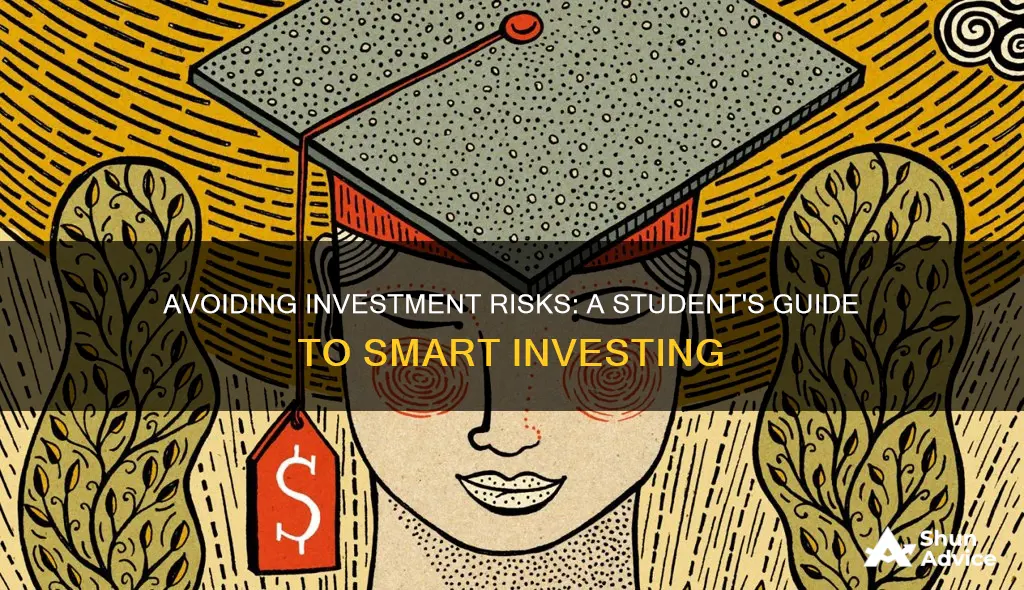
Investing is a great way to grow your money, but it's important to understand the risks involved. The main risk of investing is losing money, and there is also a chance you won't achieve your expected returns. While it's impossible to eliminate investment risk, students can take steps to manage it and make informed decisions. Understanding the risks and rewards of different investment options is key, and creating a financial plan that suits your risk tolerance and goals is essential. Diversifying your investments is a common way to manage risk, and seeking out independent research and professional advice can help you avoid scams and fraud.
| Characteristics | Values |
|---|---|
| Understand the basics | Know the basics of saving and investing, and the risks and returns of different investment products |
| Do your research | Research the company and its products or services before investing |
| Know your risk tolerance | Evaluate your comfort zone with taking on risk and how much risk is appropriate for your financial goals |
| Diversify your investments | Spread your risk by investing in a range of asset classes and investment vehicles |
| Have an emergency fund | Save up 3-6 months' worth of expenses before investing |
| Avoid debt | Pay off any high-interest debt |
| Be cautious | Be wary of unsolicited offers, pressure to invest quickly, and offers that sound too good to be true |
What You'll Learn

Understand the basics of saving and investing
Understanding the basics of saving and investing is essential for financial security and managing your money. Here are some key points to consider:
Understanding Risk and Return
Firstly, it's important to recognise that every saving and investment product has different risks and returns. Savings accounts, insured money market accounts, and CDs are generally considered very safe because they are federally insured, and you can easily access your money. However, the trade-off is that the interest rate on savings is typically lower compared to investments. While savings are relatively safe, they are not entirely risk-free due to inflation. Over time, inflation can erode the purchasing power of your money, resulting in a loss of value.
On the other hand, investments like stocks, bonds, and mutual funds offer potentially higher returns but also carry higher risks. Stocks, for instance, can fluctuate widely in value, and there are no guarantees of profits. Bonds generally provide higher returns than savings but lower returns than stocks, and they are less risky than stocks as bondholders know how much money they expect to receive unless the issuer declares bankruptcy. Mutual funds, meanwhile, are subject to the underlying risks of the stocks, bonds, and other investments they hold, and there are no guarantees of returns or protection against loss.
Evaluating Your Risk Tolerance
Before investing, it's crucial to evaluate your comfort zone in taking on risk. All investments carry some degree of risk, and you could lose some or all of your money. The key is to understand your risk tolerance and financial goals. If you have long-term financial goals, you may be willing to take on more risk for the potential of higher returns. Conversely, if you have short-term goals or prefer stability, investing in lower-risk assets like cash equivalents may be more appropriate.
Diversification and Asset Allocation
To mitigate risk, diversification and asset allocation are essential strategies. Diversification means spreading your investments across different asset classes, industries, or companies. By not putting all your eggs in one basket, you reduce the potential for substantial losses. Asset allocation refers to the way you weigh your investments to meet your financial goals, taking into account your risk tolerance, tax situation, and time horizon. For example, if you're pursuing growth and are comfortable with market risk, you may allocate a larger portion of your portfolio to stocks, which historically have provided higher average returns but come with higher risk.
Dollar-Cost Averaging
Dollar-cost averaging is an investment strategy where you invest a fixed amount of money at regular intervals, regardless of market conditions. By doing so, you buy more shares when the market is low and fewer shares when it's high, helping you build wealth gradually and avoid emotional investment decisions.
Avoiding Fraud
When investing, it's crucial to be vigilant against fraud. Always research investments thoroughly, understand the company and its products or services, and be wary of unsolicited offers or high-pressure sales tactics. Know the salesperson and check their disciplinary history. Compare promised yields with current returns on well-known stock indexes, as extremely high-return promises are often signs of extreme risk or fraud. Remember, if it sounds too good to be true, it probably is.
India Nifty 50: Tracking Index Funds for Smart Investments
You may want to see also

Evaluate your risk tolerance
Evaluating your risk tolerance is a crucial step in making investment decisions. Here are some detailed and instructive guidelines for students to assess their risk tolerance:
Understand the Basics of Risk and Return:
Start by understanding the relationship between risk and return. In simple terms, the higher the potential return, the higher the risk involved. Stocks, for example, have the potential for high returns but are also one of the riskiest investments due to their volatility. On the other hand, savings accounts are considered very safe but typically offer lower interest rates.
Assess Your Financial Goals:
Consider your financial goals and the time horizon for those goals. If you have a long-term investment horizon, you may be able to take on more risk as you have time to recover from potential losses. For shorter-term goals, more conservative investments with lower risk may be more appropriate.
Evaluate Your Comfort with Risk:
Be honest with yourself about your comfort level with taking risks. Are you comfortable with the possibility of losing some or all of your investment? Are you willing to take on higher-risk investments for the potential of higher returns? It's important to know your limits and not take on more risk than you can handle.
Diversification and Asset Allocation:
Diversifying your investments across different asset classes, such as stocks, bonds, and cash, can help reduce risk. By spreading your investments, you lower the impact of any single investment performing poorly. Additionally, consider your asset allocation, which is how you distribute your investments across these asset classes. A common strategy is to allocate a larger portion of your portfolio to stocks for growth and a smaller portion to bonds for stability.
Dollar-Cost Averaging:
Dollar-cost averaging is an investment strategy where you invest a fixed amount of money regularly, regardless of the market conditions. This approach helps to reduce the impact of market volatility and can be a more emotionally balanced way to invest, as you're not trying to time the market.
Seek Professional Advice:
If you're unsure about your risk tolerance, consider seeking advice from a financial advisor. They can provide personalized guidance based on your goals, time horizon, and risk appetite. Remember, investing involves risk, and there are no guarantees. It's important to educate yourself, do your research, and make informed decisions that align with your financial goals and comfort level.
Lucrative Investment Zones Across India
You may want to see also

Diversify your investments
Diversifying your investments is a crucial strategy to reduce investment risk. This strategy involves spreading your investments across various asset classes, industries, and companies, rather than putting "all your eggs in one basket". Here are some key considerations for students looking to diversify their investments:
Understanding Asset Allocation
Asset allocation refers to how you distribute your investments across different asset classes, such as stocks, bonds, alternative investments, and cash. A well-diversified portfolio typically includes a mix of these asset classes. When deciding on your asset allocation, it's important to consider your financial goals, risk tolerance, tax situation, and investment timeframe. For example, if you are pursuing growth and are comfortable with market risk, you may allocate a larger portion of your portfolio to stocks, while also including some bonds to balance out the risk.
Selecting a Variety of Investments
Within each asset class, aim to choose a variety of investments. For example, if you are investing in stocks, consider buying shares in multiple companies across different industries. This way, if one company or industry experiences a downturn, your losses can be potentially offset by gains in other areas. This strategy helps to reduce the impact of major market swings on your portfolio. Remember, diversification does not eliminate risk, but it can help to mitigate it.
Mutual Funds and Multi-Asset Funds
Mutual funds are a popular way to diversify your investments. They are a type of pooled investment vehicle that gives you access to multiple assets with a single investment. Mutual funds are professionally managed and operated by money managers who maintain the portfolio according to its investment objectives. Multi-asset mutual funds are another option, where the fund manager selects a range of asset types to match specific risk appetites. These funds can provide a cost-effective way to diversify your portfolio.
Time Horizons and Emergency Funds
When diversifying your investments, consider your time horizon, which is the amount of time you have to reach your financial goals. Longer investment horizons generally allow for taking on more risk, as there is more time to recover from any market downturns. It's also crucial to have an emergency fund in place before investing. This fund should ideally cover 3 to 6 months' worth of expenses, ensuring that you don't have to sell your investments prematurely if unexpected costs arise.
Regularly Rebalancing Your Portfolio
Diversification isn't a one-time task; it's an ongoing process. Regularly review and rebalance your portfolio to ensure it aligns with your original asset allocation plan. This helps to maintain a comfortable level of risk and ensures your portfolio stays on track with your financial goals. While there is no one-size-fits-all approach to rebalancing, many financial experts recommend doing so every six or twelve months or when the relative weight of an asset class deviates from your desired allocation.
Value Investing in India: Strategies for Long-Term Wealth
You may want to see also

Research before investing
Researching before investing is a crucial step in mitigating investment risks. Here are some detailed and direct instructions for students on how to research effectively before investing:
Firstly, understand the company you are considering investing in. Look beyond the surface-level information and dig into their business operations, products, and services. This will help you gauge the stability and potential of the company. Seek out their financial statements and analyse them to make informed decisions. Websites like the SEC's EDGAR filing system can be a great resource for this.
Secondly, be cautious of unsolicited offers and investments. Be wary of investing based solely on unsolicited emails, message board postings, or company news releases. Conduct your independent research and be especially cautious if you cannot find current financial information about the company from independent sources. Remember, if an offer seems too good to be true, it probably is.
Thirdly, know the salesperson or intermediary. Even if you know them socially, check their credentials and disciplinary history. Verify if they are licensed to sell securities in your state and whether they have had any issues with regulators or other investors. You can use the SEC's and FINRA's online databases for this purpose.
Additionally, be aware of the different types of investments available and the associated risks. Understand the difference between stocks, bonds, mutual funds, and other investment vehicles. Each has its own risk profile, with stocks generally considered riskier than bonds, and both riskier than savings accounts. Government securities, for example, offer a guaranteed principal and interest, while stocks come with higher risk and potential returns.
Finally, be mindful of your financial goals and risk tolerance. Create a financial roadmap that outlines your short-term and long-term goals. This will help you determine the appropriate mix of investments for your portfolio. Remember, investing should be seen as a medium- to long-term commitment, and you should ideally have an emergency fund covering 3 to 6 months' worth of expenses before investing.
Condo Investment: A Smart, Secure, and Profitable Move
You may want to see also

Be aware of fraud
Students are particularly vulnerable to scams and investment fraud. With the rise of social media and the unregulated world of cryptocurrency, students are more susceptible to a new wave of phishing attacks and online investment fraud.
- Be vigilant and do your research. When considering investing, especially in unregulated forms like cryptocurrency, it's crucial to be cautious and conduct thorough research.
- Recognize phishing attempts. Phishing is a fraudulent practice of sending emails or texts purporting to be from reputable companies to induce individuals to reveal personal information. Be cautious of suspicious emails, texts, or phone calls and never disclose your private information.
- Be wary of "get rich quick" schemes. Investment scams often pressure individuals to make impulsive decisions by offering deals with time limits. Take your time and don't rush into any investment opportunity.
- Verify celebrity endorsements. Fraudsters often leverage celebrity endorsements, especially those with a younger audience, to gain trust and credibility. Be cautious and verify any endorsements before investing.
- Stay informed about fraud prevention. Educational interventions have been shown to increase individuals' ability to recognize fraudulent investment opportunities. Seek out resources and information to enhance your knowledge and protect yourself from fraud.
- Report suspicious activity. If you encounter suspicious emails, texts, or phone calls, report them to the relevant authorities. By reporting these scams, you can help build a larger picture of fraudulent activity and reduce future crimes.
Understanding Risk: Barron's Handbook Explained
You may want to see also
Frequently asked questions
The main risk of investing is losing money. You might not get back what you put in. There's also a risk that you won't achieve your expected returns over a particular time period.
One way to reduce the risk of losing money is to diversify your investments. This means putting your money in a range of investments, so if one performs badly, it could be balanced out by another.
Lower-risk investments typically contain a mix of cash and fixed-income assets, while higher-risk investments may have more equities. Each mutual fund has a risk profile, which gives you an idea of the level of volatility to expect.
The longer your investment horizon, the greater the risk you can afford to take, as you have more time to recover from market downturns.
Dollar-cost averaging is when you invest a fixed amount of money into the same investment vehicle(s) on a regular basis, regardless of how the market is performing. This strategy can help you avoid making emotional investment decisions and reduce investment risk.







